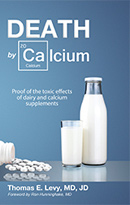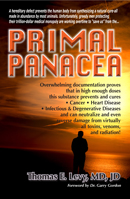25-Hydroxyvitamin D levels and the risk of mortality in the general population.
By Melamed ML., Michos ED., Post W., Aster B.Division of Nephrology, Department of Medicine, Albert Einstein College of Medicine, 1300 Morris Park Ave, Ullmann 615, Bronx, NY 10461, USA. mmelamed@aecom.yu.edu
BACKGROUND: In patients undergoing dialysis, therapy with calcitriol or paricalcitol or other vitamin D agents is associated with reduced mortality. Observational data suggests that low 25-hydroxyvitamin D levels (25[OH]D) are associated with diabetes mellitus, hypertension, and cancers. However, whether low serum 25(OH)D levels are associated with mortality in the general population is unknown. METHODS: We tested the association of low 25(OH)D levels with all-cause, cancer, and cardiovascular disease (CVD) mortality in 13 331 nationally representative adults 20 years or older from the Third National Health and Nutrition Examination Survey (NHANES III) linked mortality files. Participant vitamin D levels were collected from 1988 through 1994, and individuals were passively followed for mortality through 2000. RESULTS: In cross-sectional multivariate analyses, increasing age, female sex, nonwhite race/ethnicity, diabetes, current smoking, and higher body mass index were all independently associated with higher odds of 25(OH)D deficiency (lowest quartile of 25(OH)D level, less than 17.8 ng/mL [to convert to nanomoles per liter, multiply by 2.496]), while greater physical activity, vitamin D supplementation, and nonwinter season were inversely associated. During a median 8.7 years of follow-up, there were 1806 deaths, including 777 from CVD. In multivariate models (adjusted for baseline demographics, season, and traditional and novel CVD risk factors), compared with the highest quartile, being in the lowest quartile (25[OH]D levels less than 17.8 ng/mL) was associated with a 26% increased rate of all- cause mortality (mortality rate ratio, 1.26; 95% CI, 1.08-1.46) and a population attributable risk of 3.1%. The adjusted models of CVD and cancer mortality revealed a higher risk, which was not statistically significant. CONCLUSION: The lowest quartile of 25(OH)D level (less than 17.8 ng/mL) is independently associated with all-cause mortality in the general population.
Comments from Dr. Levy
Vitamin D has long been known as the sunshine vitamin, and for a very long time the role it is known to play in calcium metabolism and bone health has been considered to be its only significant function. This has been conclusively proven to be an extremely restrictive view of the utility and importance of vitamin D. Specific receptors for binding and utilizing vitamin D have now been discovered in nearly all the different tissues in the body. Vitamin D has been shown to inhibit the unrestrained proliferation of cells, such as is seen in most cancers. Vitamin D deficiency has been shown to be consistently associated with an increased incidence of a host of different diseases, most notably a wide variety of cancers (including bladder, breast, colorectal, esophageal, lung, oral/pharyngeal, pancreatic, prostate, and kidney cancer; also melanoma and non-Hodgkin's lymphoma), but also heart disease, multiple sclerosis, rheumatoid arthritis, and diabetes.
The study cited above is but another piece of evidence clearly in support of the extreme importance of normal vitamin D levels and vitamin D metabolism in maintaining (or possibly restoring) good health. In a nutshell, the 20% of the patients with the lowest vitamin D blood levels had a 26% increased rate of death from all causes over the 20% of the patients with the highest vitamin D blood levels. This is a simple, straightforward, yet very profound testament to the importance of having enough vitamin D in the body.
It is especially important to specifically address all the measures necessary to maintain normal vitamin D levels since there is no substitute for it. If you eat and supplement perfectly but neglect your vitamin D, a very low level of this vitamin can single-handedly cause you to have a substantially greater risk of death or grave disease versus those individuals who manage to maintain normal vitamin D levels.
On the other hand, as very important as vitamin C is for so many things, a lack of proper vitamin C intake can, at least partially, be compensated for by the substantial ingestion of other quality antioxidants, as they all work together synergistically. This is decidedly not the case with vitamin D. The vitamin D receptors in the tissues of the body are designed specifically for vitamin D, and if enough of them remain unbound due to a lack of vitamin D, compromised health will generally not be too far away.
It is a theory of mine that all positive nutrients, supplements, and vitamins are antioxidant, or electron-donating, to some degree. Vitamin D likely donates electrons as well, but its unique chemical structure is required for it to donate its electrons to the sites specifically designed for it (vitamin D receptors). It is unlikely that an onslaught of chemically nonspecific antioxidants could replace the role of vitamin D, although they can certainly mitigate or lessen the toxic effects of the oxidative stress resulting from the consequences of depleted levels of vitamin D.
So what to do? Since vitamin D excess can be as devastating to the health and long-term survival as a vitamin D deficiency, it is not advisable to just take a supplement and hope for the best. You want to avoid vitamin D excess just as much as vitamin D insufficiency. Vitamin D supplementation should be guided by the blood levels of its direct precursor, 25-hydroxy-vitamin D (calcidiol). As exotic as it sounds, it is a relatively inexpensive and easily obtained test. If your health care practitioner does not seem eager to help you with such testing, it is also available through the Life Extension Foundation (www.lef.org)
There is also some controversy as to what is the best level of vitamin D to maintain. While most researchers and clinicians would agree that below 30 ng/ml represents a clear deficiency, with lower levels representing even greater clinical urgencies, the upper levels are less well-defined. A reasonable goal would be to achieve and maintain blood levels on the calcidiol blood test at 60 ng/ml or greater. If your level ever exceeds 100 ng/ml then measures should be taken to lessen your vitamin D intake so that you can eventually drop below this level
Supplementation should be in the form of vitamin D3 (cholecalciferol), not vitamin D2 (ergocalciferol). It is also very important to take such supplementation in an isolated manner, not with calcium. The simultaneous administration of excess vitamin D3 with calcium can significantly increase the risk of cardiovascular disease, cancer, and other diseases associated with abnormal calcium deposition, such as stone disease. Far too many osteoporosis patients are supplementing their way to this state of abnormal and ectopic calcium deposition throughout their bodies, often largely to the exclusion of their bones, the intended but rarely reached target of the supplemented calcium.
Before starting supplementation, a baseline blood test is a very good idea. A follow-up test can then be performed 3 to 6 months down the road. An initial test of 50 to 60 ng/ml is very rare, but if that is your level, your lifestyle (usually involving significant sun exposure) is doing the trick for you, and no additional supplementation would be indicated. For 30 to 50 ng/ml, a starting dose of 800 to 2,000 IU is probably in order, and individuals with less than 30 ng/ml should consider doses ranging from 2,000 to 10,000 IU daily.
These are very general guidelines only. Everybody is going to be a little bit (or a lot) different in how much of a response occurs for a given dose. If you end up taking a higher dose of vitamin D3, do your follow-up blood test at closer to the 3-month point, while 6 months later for the test would be fine if you opt for a lower dose.
Occasional individuals persist with low levels of vitamin D3 despite substantial supplementation. Sun exposure can help to restore normal levels, but the latitude at which one lives can play a strong role in almost negating the effect of the sun. A much more reliable way to normalize vitamin D levels when supplementation seems not to be reaching the point desired is to purchase a sun lamp. The ultraviolet radiation from this lamp will reliably have the same effect as the sun, except that it can be monitored much more closely not to be excessive. The goal here is not to tan, but just to induce the necessary biochemistry in the skin to synthesize vitamin D. Many individuals will normalize vitamin D levels with 5 to 15 minutes over their backs, abdomens, or upper thighs several times a week, or possibly even daily when added to the ineffective supplementation regimen.
Care needs to be taken never to routinely use the lamp beyond the very beginning of minimal erythema (reddening) of the skin. In fact, the erythema should disappear promptly after the treatment ends. Not even reaching the erythema point would be optimal. If erythema does not promptly resolve, future treatments should be for lesser periods of time, less frequently, and possibly at a greater distance from the skin. Most individuals can eventually work out an optimal exposure regimen for their bodies.










